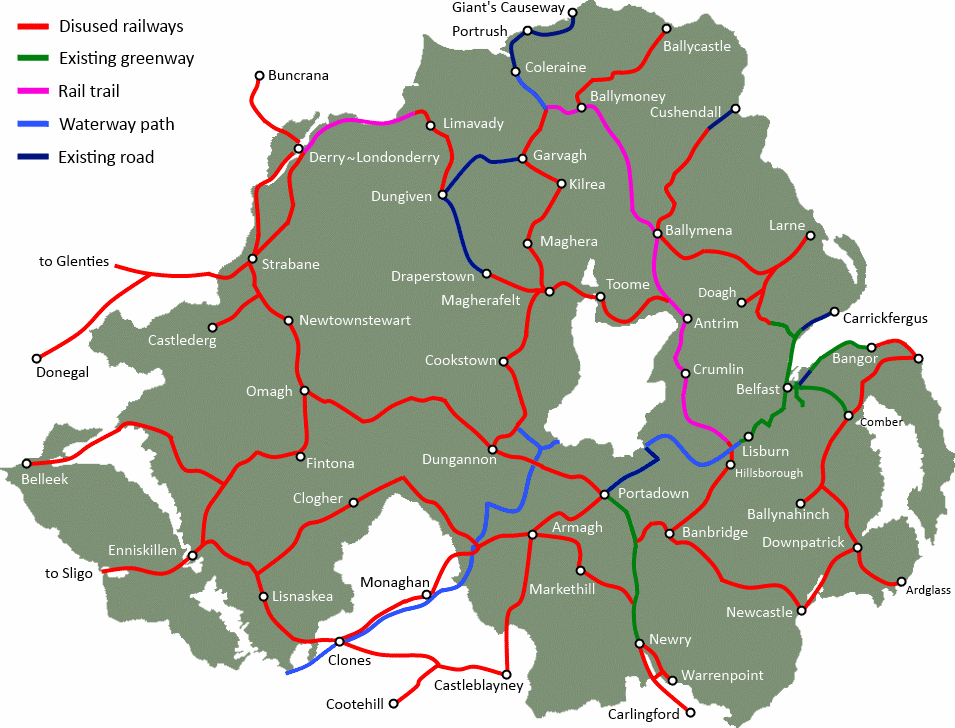
The towns of Cookstown, Moneymore and Magherafelt were once linked by a railway that now lies derelict. The old line, which winds through the Mid Ulster countryside, could be regenerated to provide a high quality 11 mile walking path and cycle route. This could be an important part of an orbital pathway around Lough Neagh, and a key tourist route west of the Bann.

[googlemaps http://maps.google.co.uk/maps/ms?msa=0&msid=202802535379582075161.0004c0a70da5df9ad48d3&hl=en&ie=UTF8&t=p&ll=54.710342,-6.659088&spn=0.218173,0.822601&z=10&output=embed&w=600&h=275]
Note for readers: open larger map, select ‘Satellite’ and you can zoom in to trace the trackbed route.
Cookstown to Moneymore pathway
The two former railway stations in Cookstown still stand today; one redeveloped as a Chinese restaurant, the other houses the Cookstown Hockey Club. Within the site of the current Lidl supermarket, the railway bridge at Limekilm Lane is visible, pointing to the northern route of the former Belfast and Ballymena Railway Cookstown extension line. These richly historic and cherished pieces of Cookstown heritage could form a new gateway for regional walking, rambling and cycling.
Great Northern Railway station site in Cookstown
[googlemaps http://maps.google.co.uk/maps/ms?msa=0&msid=202802535379582075161.0004c0a70da5df9ad48d3&hl=en&ie=UTF8&t=h&layer=c&panoid=ZObYV8C64E4Ood4YqEmQoA&cbll=54.645955,-6.739393&cbp=13,24.86,,0,-4.62&source=embed&ll=54.623177,-6.739426&spn=0.079507,0.411987&z=11&output=svembed&w=600&h=200]
Heading northeast out of the town, the line runs 4 miles to Moneymore. The route crosses the Old Coagh Road, Lismoney Road and the Tullyboy Road, and cuttings and embankments are clearly visible on satellite images. Residential development on and adjacent to the line make a linear route difficult, and some diversions would need to be considered. However negotiated diversions are possible to maintain a new route’s integrity. The line skirts alongside Moneymore, and quality links for walkers and cyclists into the town would encourage greater local use and touring stopovers. A 4 mile journey to Cookstown means some modal shift from private car to cycling is possible for leisure, shopping or commuting journeys.
Cookstown-bound route from Turnaface Road Moneymore
[googlemaps http://maps.google.co.uk/maps/ms?msa=0&msid=202802535379582075161.0004c0a70da5df9ad48d3&hl=en&ie=UTF8&t=h&layer=c&panoid=krCjNt_dglDZr5ZOrFTtVg&cbll=54.69355,-6.674918&cbp=13,210.9,,0,-0.29&source=embed&ll=54.659436,-6.674881&spn=0.119154,0.411987&z=11&output=svembed&w=600&h=300]
Moneymore to Magherafelt cycling and walking route
Leaving Moneymore there is significant development as the route approaches and crosses Lawford Street, where a lengthy on-road diversion may be a prudent option. Heading out into the countryside, the railway line is mostly still intact, with some sections taken over for agricultural use. There are local farmhouse B+Bs which could benefit from this rambling and walking pathway, and The Jungle outdoor activity centre is close to the proposed Greenway. There are 4 residential building in close proximity to the line, where diversions may be needed. Several bridges over roads could be restored as part of a new Greenway, and the line has wonderful countryside views from embankments.
At the Roshure Road the Greenway route turns east towards Magherafelt, and a junction joins the proposed Magherafelt to Draperstown Greenway. The Greenway terminates at the Mid Ulster Hospital, an important node for short walking journeys.
Cookstown tourism
As shown by the Comber Greenway project, reopening former railway lines to provide leisure space for local communities can be a success in Northern Ireland. A wider Northern Ireland Greenways network of over 600 miles across the province would enhance Northern Ireland’s tourist proposition. Cookstown, Moneymore and Magherafelt could develop a significant hospitality sector to serve touring cyclists and other active holidaymakers. The health benefits to the local population could begin to repay the investment, with active leisure, local travel and commuting journeys made possible as an alternative to private car. All this while is possible while also regenerating and preserving our industrial and engineering heritage.